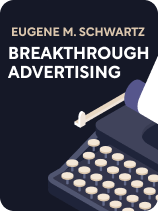

This article is an excerpt from the Shortform book guide to "Breakthrough Advertising" by Eugene M. Schwartz. Shortform has the world's best summaries and analyses of books you should be reading.
Like this article? Sign up for a free trial here.
What are the five levels of customer awareness? Why are these levels important to consider when selling a product?
Once you’ve chosen the specific customer need your headline will target, you need to find out how much they already know about your product. According to Eugene M. Schwartz in Breakthrough Advertising, this will help you determine what type of information you should put in your headline.
Let’s look at the different levels of customer awareness and how to create headlines for each.
Customer Awareness of Your Product
According to Schwartz, customers move through five different levels of awareness as they learn more about your product. Each level of customer awareness determines how much information you must provide in the headline to get customers to consider your sales pitch.
(Shortform note: Seth Godin (Purple Cow) expands on why you should pay attention to customer awareness levels. Knowing exactly what customers already know about your product makes it easier to understand their perspective—how they judge your product. This understanding helps you frame your content in a way that engages and educates customers. For example, customers unaware of a product’s purpose don’t understand its value—so, when you show them the price up front, they might judge it as overpriced. However, when you know that customers don’t understand your product, you can sway them into perceiving it as a good deal by educating them on the product’s value before mentioning the price.)
Schwartz suggests that you should find out what level of awareness the majority of your customers currently have and write a headline that caters to how much they know about your product. Let’s explore his advice for crafting headlines for each awareness level.
Awareness #1: Customers Don’t Feel Like They Need Your Product
The first level of customer awareness represents customers who don’t recognize or acknowledge the need that your product satisfies. This means that they’re either unaware of your product or don’t care about it.
Schwartz suggests that your headline should echo an emotion or an attitude that they can identify with. You can then use your copy to educate them on why they need your product. For example, when advertising a dating app, you could use the headline, “Have you forgotten what it’s like to be in love?”
(Shortform note: Marketing experts expand on Schwartz’s advice for appealing to customers who don’t feel like they need your product. For a product to create a new desire in customers, it must have five characteristics: newness, surprise, intricacy, mystery, and an ability to raise questions in the customer. For example, the iPhone is a notable example of a product that created a customer desire that hadn’t existed before: Customers didn’t want hand-held computers that could make calls and browse the internet because they didn’t know it was possible. This changed in 2007 when Apple generated hype with an intriguing marketing campaign that showcased the product’s novelty.)
Awareness #2: Customers Feel a Need—But Don’t Know How to Fulfill It
The second level of customer awareness represents customers who are aware that they require something to fulfill the specific need your product satisfies but they don’t yet know about any potential solutions—including yours.
Schwartz suggests that your headline clearly defines the need you’re targeting, convinces customers that they urgently need a solution, and then presents your product as the inevitable solution. For example, “Are you tired of feeling alone and unwanted? Download our app and you’ll never be single again.”
Awareness #3: Customers Know How They Want to Fulfill the Need Your Product Satisfies
The third level of customer awareness represents customers who are aware of the need your product satisfies, and they know how they want to fulfill it. However, these customers don’t know that your product can provide the solution they seek.
Schwartz suggests that your headline should emphasize three points:
- A definition of the specific customer need
- Proof that it’s possible to fulfill that need
- An illustration of how your product fulfills that need.
For example, “Sick of bad dates? Sign up for [app name] where all the good ones hang out!”
Awareness #4: Customers Aren’t Sure About Your Product
The fourth level of customer awareness represents customers who aren’t sure that your product can fulfill their needs. This is because they either don’t have enough information about your product, or they feel skeptical about the product information that they have seen.
To engage customers at this awareness level, Schwartz suggests that your headline should focus on achieving one of five objectives:
1) Reinforce their need for your product: For example, “Don’t waste your life waiting for the one.”
2) Emphasize how good life will be once they’ve purchased your product: For example, “Have fun finding the love of your life.”
3) Prove that your product can fulfill their need: For example, “Sparks more dates, relationships, and marriages than any other dating app.”
4) Clarify how your product fulfills their need: For example, “Find the perfect someone in your own city using GPS technology.”
5) Suppress any doubts or concerns they might have about your product: For example, “Find your match in six weeks or get a full refund.”
(Shortform note: Customers often have doubts or concerns about completing a purchase when they’re under the influence of a cognitive bias called loss aversion: the tendency to worry more about what they might lose than to feel hopeful about what they might gain. This means that customers tend to focus more on the amount of money that they might lose if the product fails to fulfill their needs, rather than the number of benefits they might enjoy if the product succeeds. Marketing experts suggest that you can restrict the influence of this bias by offering customers a risk-free way to learn more about your product—for instance, by offering free samples, trial periods, and discounts.)
Awareness #5: Customers Want Your Product
The fifth level of customer awareness represents customers who already know about and want your product. They just require a little motivation to complete the purchase.
Schwartz suggests that since these customers already know about all of the features and benefits your product offers, your headline’s primary focus should be on incentivizing customers to complete the purchase. For example, “Sign up now to get 75% off!”
Customer Awareness of Your Competitors’ Products
Once you’ve figured out what your customers want and how aware they are of your product, find out how aware customers are of competitive products. This will help you determine how much emphasis to place on distinguishing your product from similar versions in the market.
Let’s explore Schwartz’s advice for distinguishing your product for two different types of customers:
- Customers who are unaware of competitive products
- Customers who are aware of competitive products
Customer Group #1: Unaware of Competitive Products
According to Schwartz, if customers aren’t aware of similar versions of your product, your headline should be as simple and direct as possible. For example, “Finally, an effortless way to find love!”
Customer Group #2: Aware of Competitive Products
If customers are aware of a few similar versions of your product, Schwartz suggests that, instead of inventing a new headline, you simply expand on your competitors’ headlines and elaborate on why your product is better than all other versions. For example, if a competitor uses the headline, “An easy way to find love,” you can expand on their claim with: “The fastest and easiest way to find love.”
If customers are aware of many versions of your product, they won’t be as receptive to new advertisements—because they’ve already heard all of the claims and have lost interest in this type of product. Schwartz suggests two ways your headline can revive customer interest in your product:
- Emphasize a new, distinct benefit to distinguish your product from what’s currently on the market. For example, “The only app to guarantee your perfect match in under 60 seconds!”
- Express an emotion or attitude to appeal to these customers. For example, “For those who know that life should be better.”
(Shortform note: While the three research methods Schwartz suggests may help to distinguish your product, they’re unlikely to change how customers feel about the first competing product they learned about. According to Al Ries and Jack Trout (The 22 Immutable Laws of Marketing), when consumers learn about a new product, they unconsciously perceive the brand that first introduced the product as synonymous with the product itself. For example, people often refer to tissues as Kleenex—because Kleenex was the first brand to offer facial tissues. This form of attachment makes it difficult for new brands to change how customers feel about established brands with existing products—even if the new brands offer superior products.)

———End of Preview———
Like what you just read? Read the rest of the world's best book summary and analysis of Eugene M. Schwartz's "Breakthrough Advertising" at Shortform.
Here's what you'll find in our full Breakthrough Advertising summary:
- Why the headline is the most important component of an advertisement
- Specific techniques you can use to create captivating headlines
- Persuasive methods you can apply to write compelling copy






